Common Issues Engineers Discover in Structural Inspections
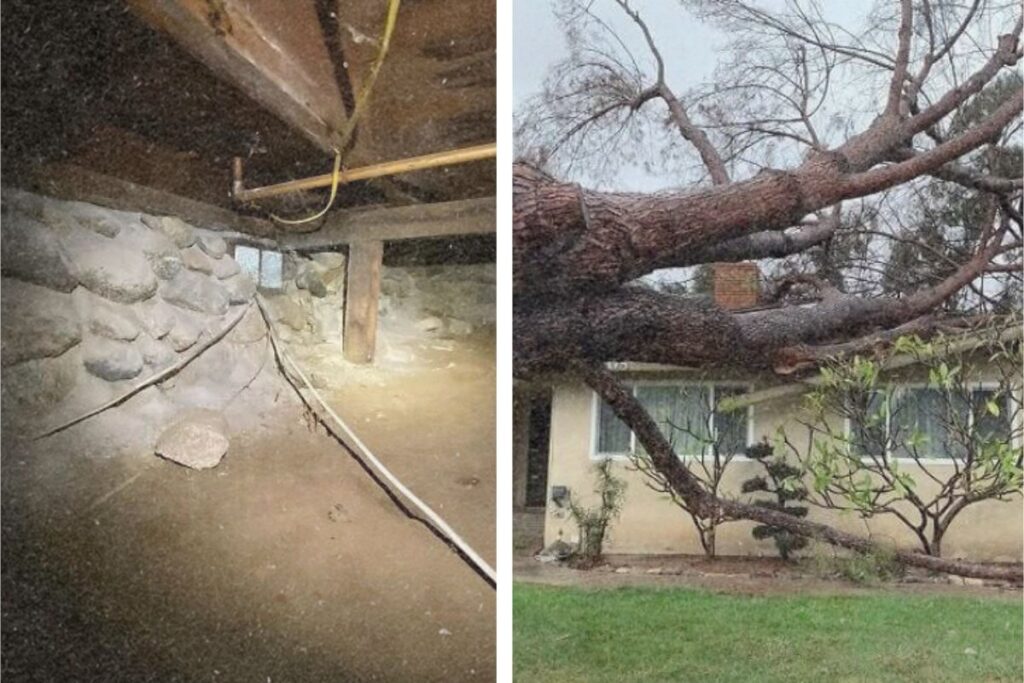
Is this the way the posts are supposed to bend?
Home inspection services are typically hired when a homeowner is preparing for a renovation. This photo has proof that old houses should be renovated, one way or another, all of the time. It certainly makes sense; the house has a life span, and wooden posts are not made to last forever, after all! We’re gonna go out on a limb here and say the guy who showed up to do this structural inspection was flabbergasted to see these posts bending with the weight of the house.
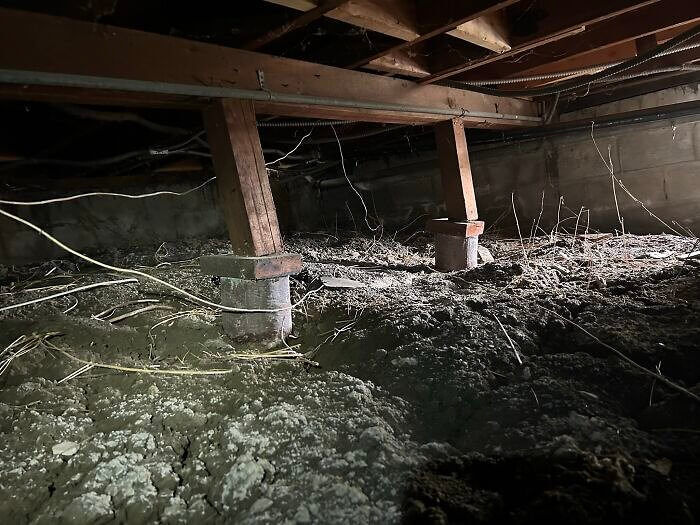
Advertisement – Continue Reading Below
Advertisement – Continue Reading Below
This Inspector better not rest his A against the house while quoting the homeowners an estimated fee! One shove sends this house right over the edge, comically.
When the Foundations Split in Half
As any building or structure would stand on the ground, the first structure that is the most important is its foundation. I mean, we all played a version of Jenga, right? The whole structure collapses if the bottom layers are broken or dislocated! Well, it’s pretty much the same thing with houses, which is why a home inspection service freaked out when they saw the below house. It initially appeared to be a flooring problem for the homeowners. But it was something much more malevolent.
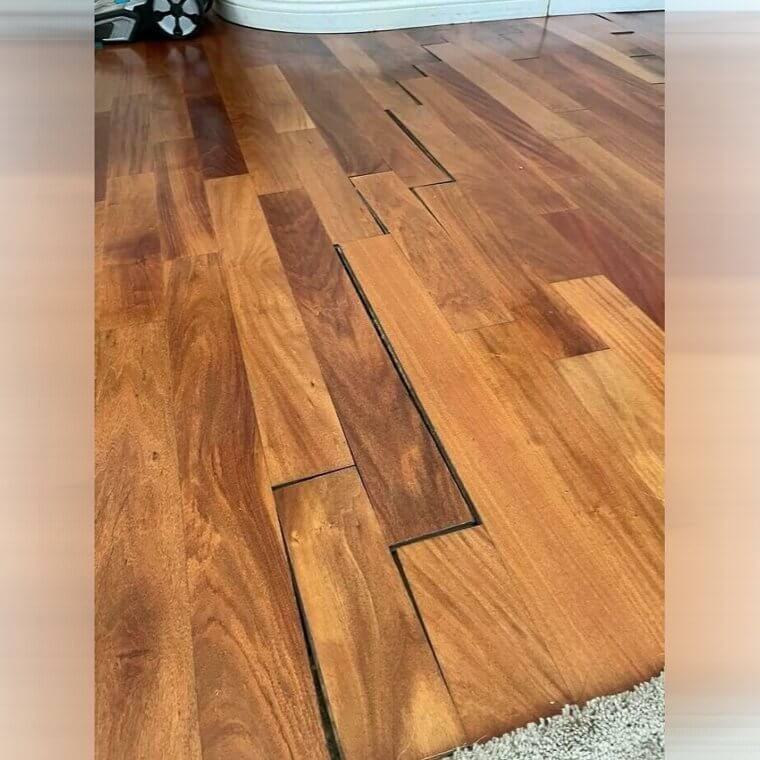
What you are actually seeing is the remaining portion of the home foundation literally cracking in half, and the home shifting accordingly. And then we bet it cost quite a lot—and that the resolution wasn’t inexpensive, either.
A Tetris-Inspired Pier and Beam Home
Those versed in structural engineering and building (or seen “The Money Pit” with Tom Hanks and Shelly Long) know that pier and beam jobs are not unusual. For even they are all around the globe. This type of construction gives a crawl space under the home, and this is where many a home inspection service will be found when they are doing structural inspections. And while pier and beams aren’t without their inadequacies, they seldom call to mind a game of Tetris.
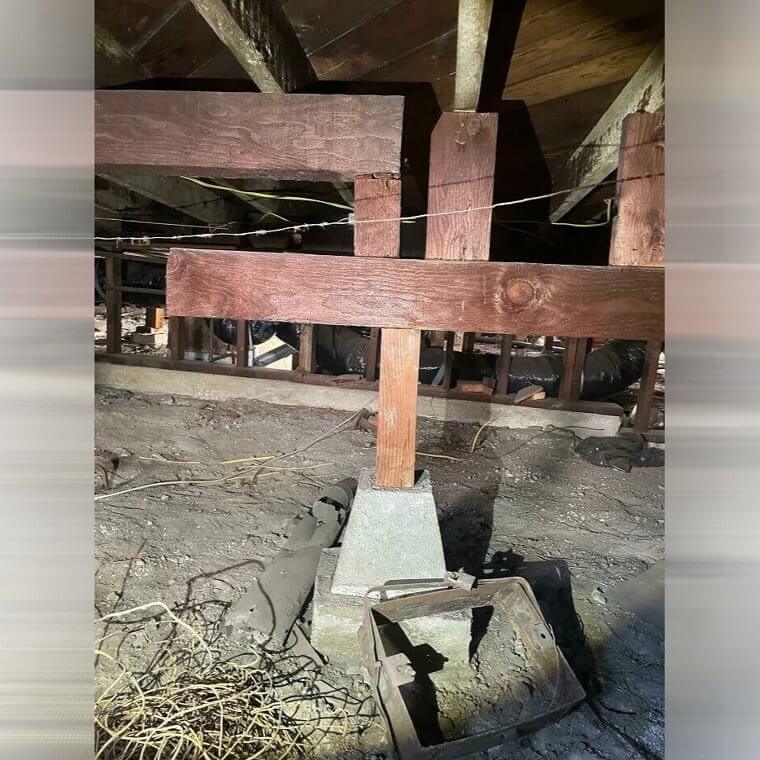
Advertisement – Continue Reading Below
The beams have not only been stacked either, they also appear to form some strange positioning and piles like the concrete stumps. This is just going to end up as an absolute shitshow.
That Roof Is Supposed to Be Straight
Earthquakes may bring a lot of sorrow to many, but one thing is for sure, it keeps home inspection companies operational. When the team arrived for this structural inspection, they could already see how badly the house had impacted the recent earthquake. The foundations were moving, there were significant cracks running through the walls and that was before we looked at the roof that should be completely flat!

No, that curve in the roof was not part of the design. This house needing repair and without a-BIGGAN WALLET. So we are guessing, they just demolished the whole thing right?
Advertisement – Continue Reading Below
Adult Foot Vs Differential Settlement
Differential settlement is often picked up in structural inspection but rarely do we see differential settlement so large. The whole thing is an absolute mess with the foundations sinking at different rates under the house (you can see a foot in the frame for scale). Those cracks go pretty damn deep — look at all those fissures. Definitely something you do NOT want to see as a homeowner.
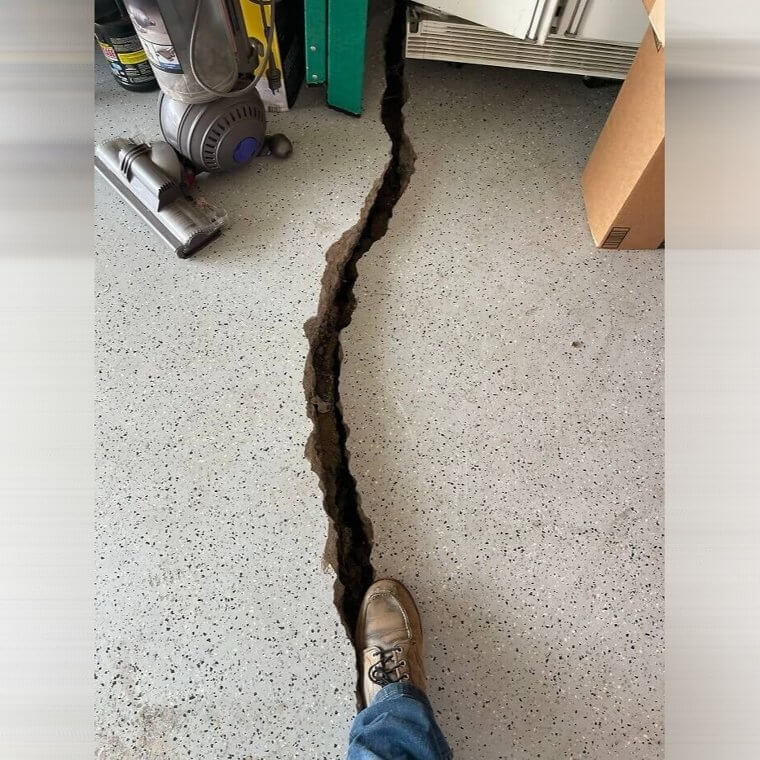
Advertisement – Continue Reading Below
Typically, we might recommend slapping some duct tape on the crack and moving on, but we suspect duct tape won’t be much use in this case. Thus, I hope the structural engineer had a better answer.
This Fungus Isn’t so Fun
However, when you think about it, fungus is a decidedly slippery term. Fungus – unequivocally not fun – and a whole lot of it was found in a structural inspection. Taken in a crawl space of a house, this image demonstrates that a lot of the beams, joists and girders had become infested with fungus. You can guess, this is a really bad sign.
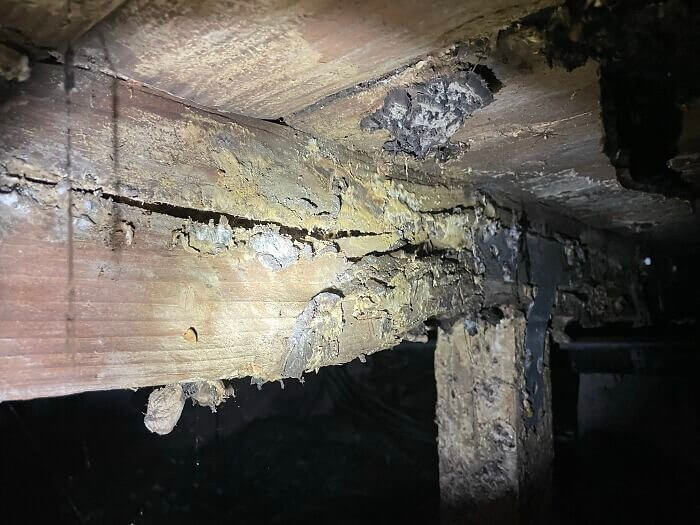
It is not just damaging for the family living within it, it is also so bad that it could be life-threatening. As this fungus thrives, their house will lose its structural integrity.
Hillside Properties and Rainstorms Don’t Mix
If we’re honest here, trashy reality shows like Selling Sunset and Buying Beverly Hills have us imagining homes in the Hollywood Hills. And sure, while these houses are appealing to the eye, a home inspection service would tell you that these houses are not built as solid as you would believe. After all: never underestimate water — or landslide-prone hills — do you live in.
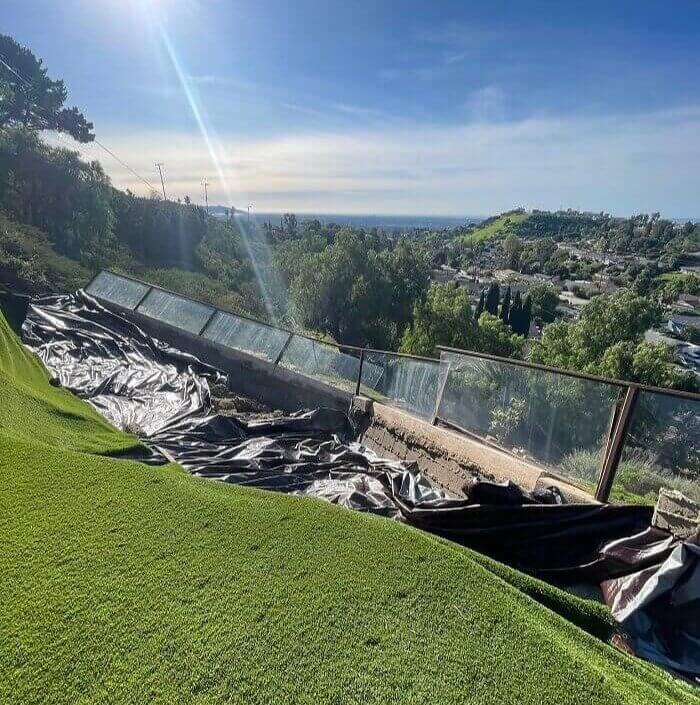
Advertisement – Continue Reading Below
The water so heavily pressed the retaining wall this time that it bowed and broke! Fortunately for these homeowners, the This time, the water forcefully pushed against the retaining wall and bent and broke the wall! Fortunately for these homeowners, it was limited to just their backyard, and not their entire home.only affected their backyard and not the entire house.
These Support Beams Aren’t Very Supportive
As you might expect from the name, a support beam provides support to the house. This means that the support beam has to be solid and stable — and it absolutely must not be rotten inside. However, that’s precisely what the home inspection service discovered when they came out to check on this stilt home. And from that view, the house is quite high up on a hill, so that’s even creepier.
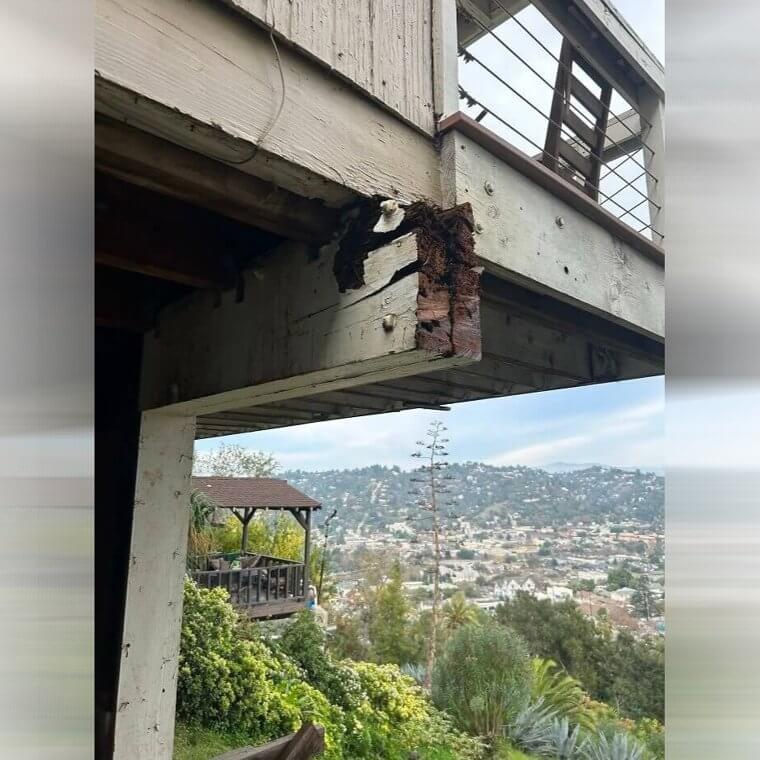
With something like this, the house would need entirely redoing and the beams completely replaced. That isn’t inexpensive, though, and it’s not exactly a breezy process, either.
When You Leave the Pool Water Running
What is better in life than having a pool?! However, a pool also comes with another set of responsibilities. You have to keep the water clean, you have to keep it safe for your children, and you have to turn it off when you need to turn it off. But unfortunately when his clients went away on vacation, the pool service technician didn’t do that – and this is what happened next.

Advertisement – Continue Reading Below
Yep the entire back yard lost its fight to the forces of a pool and the decking was shoved and decimated in the process. Well, we hope the pool company had insurance because we suspect that’s a claim coming.
If the Trees Are Bending, the Hill Is Unstable
When building on a hill, it is critical to conduct structural inspections. It is betting the farm, because you could never tell if this particular hillside is something that could stay built or not. However, when the home inspection service tried to see a troubled new construction on this property, they would discover it was [absolutely] in mortal peril, but checking out the trees about the property makes for an effective evaluation – and. Just look at those trees!

This is a clear indication that, if the trees are beginning to bend, the hill is moving and is thus unstable. If the trees are in motion, what is there to keep the footings from being in motion?
Stilt Houses and Salt Water Aren’t Friends
For real, raise your hands if you just wish you have the chance of living in a beach house? We don’t blame you. Each house right over the water with access to your own little piece of paradise, until you look down to see the stilts. Why? Because salt and stilt houses are not friends and one such inspection found that the footings of the house, were nearly entirely eaten away due to the salt water.

Advertisement – Continue Reading Below
And without these footings, there is literally no support for the house! Like the weird set of beams scattered around there yet before they laid eyes on. There was something going on which they weren’t even sure of.
No, Rotten Wood Beams Aren’t Good
While wooden beams are very common, the majority of new renovation projects are now using steel as an alternative to combat the numerous problems with using wood in construction. Although there are some wooden frames and supports that is not a matter, some upper floors check the wood wood-rotted beams found to weaken the counterbalance of the entire house. The more rotten the beams become the less support they give the whole structure of the building and it makes it less stable after all.
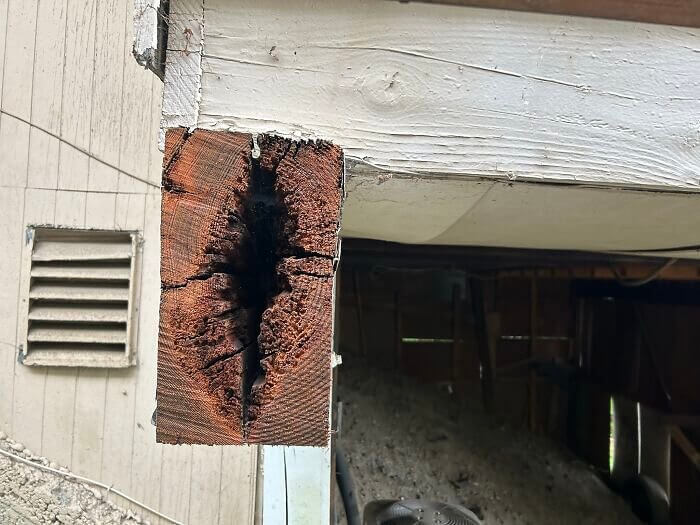
Even worse, much of this wood is rotted from the center of the beam. We can only hope that this structural inspection included a quote to remove and replace this rotting beam.
You Shouldn’t Be Able to Slide a Hand Under a Pier
In pier and beam houses, piers need to be flush to the floor and need to be in place perfectly. If they aren’t, then you undermine the integrity of the entire house so that you might end up with a much too steep and unstable house or a catastrophic, dangerous house. Yet, when the home inspection service did just a structural inspection on this pier, they actually slid their full hand under the pier and lifted it from underneath! And you likely don’t need to be told that that isn’t meant to be the case.
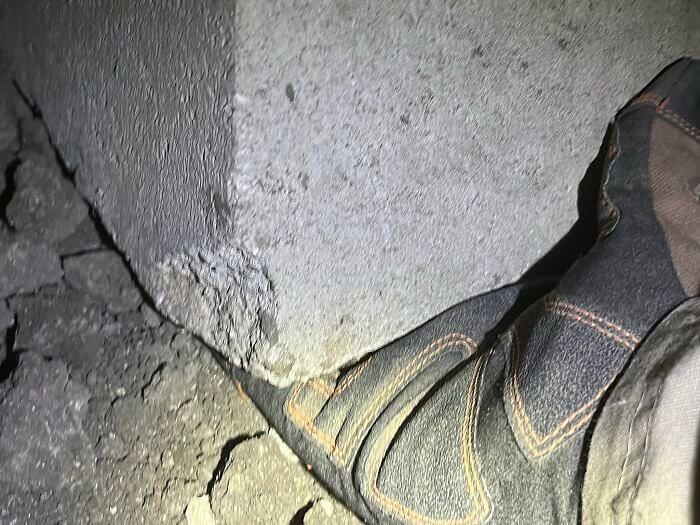
Advertisement – Continue Reading Below
No way this would happen if the piers and posts were properly installed. That makes for an outrageously costly home repair, we bet. Well, it is something they cannot afford to ignore.
Nature Will Find a Way to Infiltrate a Crawl Space
Having crawl space under your house is not just great to check out the foundations and to carry out any structural work without destroying the floor area but these crawl spaces can then go on to prove difficult – nature always wants to invade such places. This time, massive tree roots have taken up residence deep down beneath the dark and moist crawl space of this house, while simultaneously crushing the foundations.
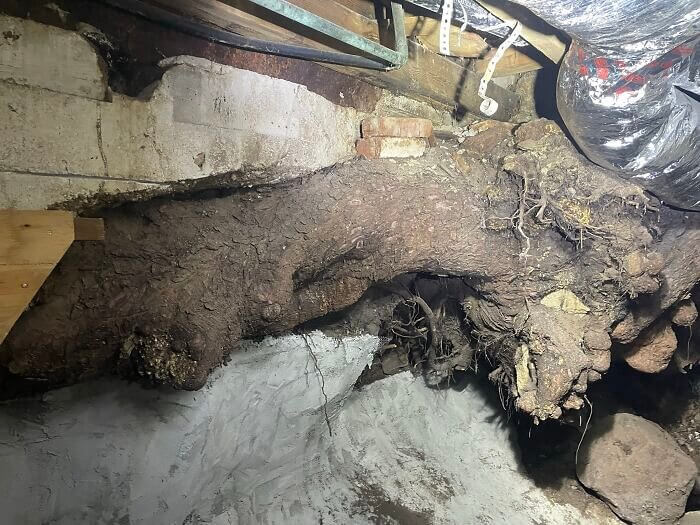
Anyway, we’re sure the owners of this house appreciate a treehouse as much as the next guy, but we bet they weren’t counting on their house becoming a treehouse — and losing their treehouse — without their permission.
The Grass and the Wall Were Once Flush
These days, and as many structural engineers will attest to with a sigh, so many homes are set on a hill and a slope. While not always a problem this can become a big problem when the hill begins to erode and slide away from the structure. When this structural inspection occurred, engineers got a first-hand view of this phenomenon.” This grass, and that wall were actually installed level with one another.
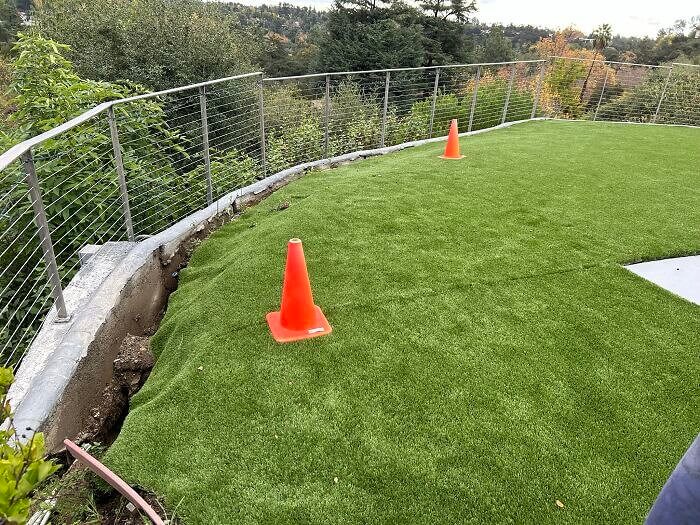
Advertisement – Continue Reading Below
The wall came down with the hillside when it started to erode and a huge gap and difference in height was left between the two. Now it certainly doesn’t pop quite the same way.
When Spall Damage Takes Hold
For the most part, high-rise structures are carried out in concrete. And while this makes them hard and stable, it is a fact that concrete is not proof against bullets. Spall damage is a trait that concrete can commonly be a victim of and this can finally result in buildings collapsing. Which is why it was so alarming when this home inspection service detected this spall damage on the ceiling in the basement garage of this high-rise block of flats.

Untreated this entire roof could collapse on the cars below and destabilise the building at the same time. We can only hope this had been flagged and fixed.
The Leaning Wall of the Parking Garage
This may seem like the wall of just another parking garage at first. To those of you who understand structural engineering and structural inspections, you’ll realize that this is a far more dangerous game than that. Take a glance towards the top of this garage, and you can see that the vehicular barrier wall is off-kilter. And while that is certainly alarming, even more alarming than that is the fact that the information is not on the ground floor.
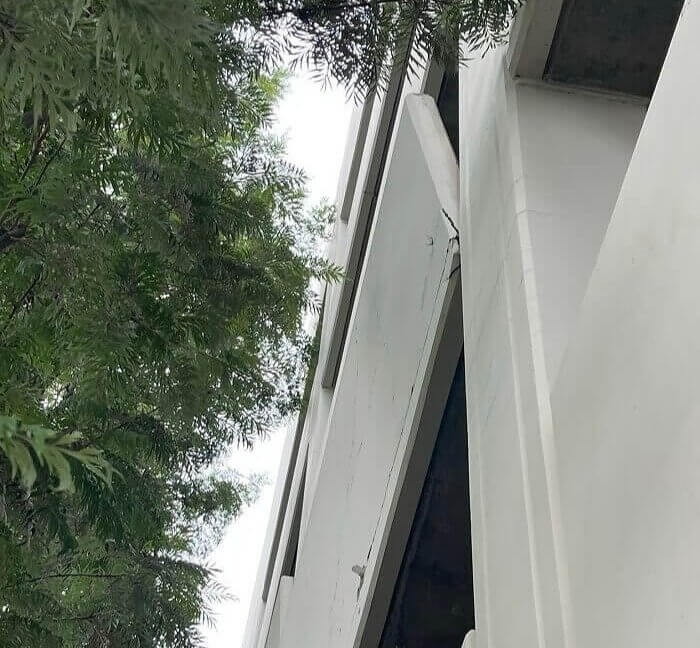
Advertisement – Continue Reading Below
If that wall gave way and fell to the ground, who knows the tracking it could knock down. Because of this, we strongly hope that this parking lot is newly renovated and remodeled.
A Retaining Wall on Its Last Legs
Retaining wall is an extremely important structure, more so if it is built next to a house. It holds everything together and offers the primary structure support. But, as this picture shows, this retaining wall is at the end of its life. It is being tipped over and the groundwater is doing that, with the weight of the saturated soil behind it, the whole thing is bent due to bad drainage.
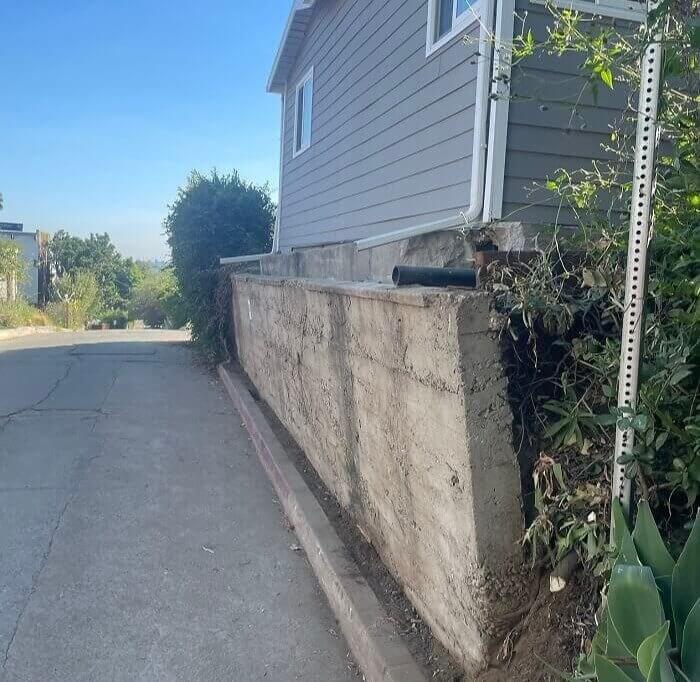
Structural inspections say this entire wall will have to be replaced someday soon. And we can bet that isn’t going to be a reasonably priced DIY repair.
A Leaking Bathtub Gone Wrong
In case you have trouble reading, this is the bottom of a tub. Armed with that intel, put on your structural engineer cap and eye this picture appropriately. What can you see? So, look, one of the big beefs we have with this pic? That light switch on the wall under the tub? We do, however, have another complaint, the spalling and exposed rebar on display.
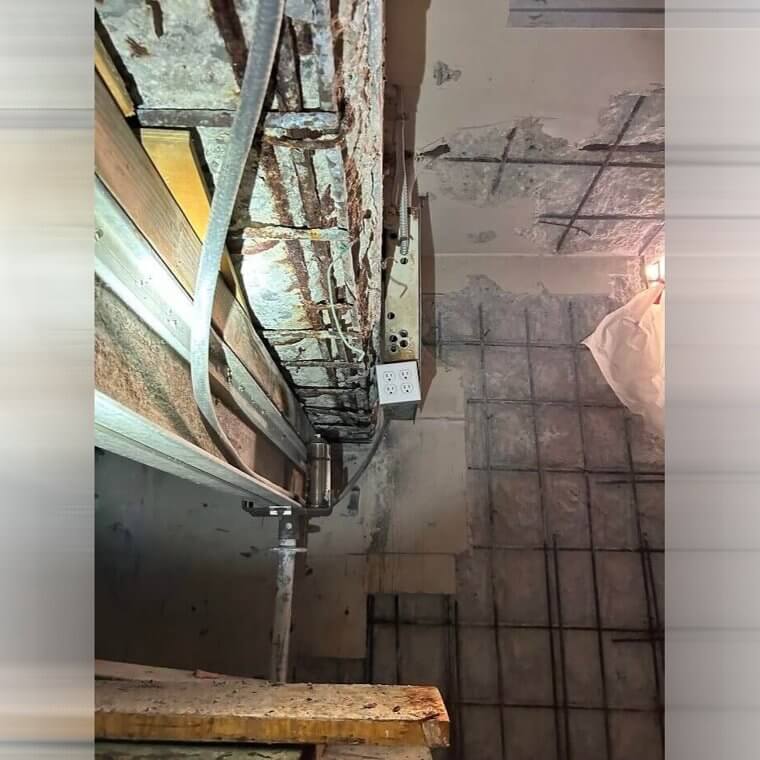
Advertisement – Continue Reading Below
This is a leak from bathtub but these shouldn’t be seen from naked eyes. The structural inspection advised the homeowners to demolish and rebuild the entire space.
What’s That Gap for?
There is no homeowner who wants to find out that they have problems with the foundations of their home, but this is the exact reason why structural inspections are useful for keeping your structure in check. In a perfect world, your home has no problems. But sometimes — in this case — the problems from your foundation issues move your whole house. Indeed, this wall and the house as close as you and I met.
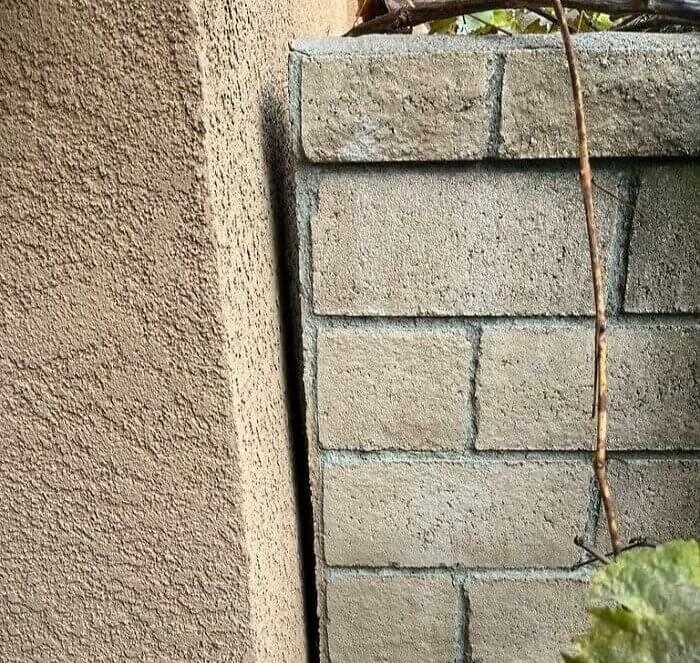
The house and the wall have moved apart over time and have created a gap that certainly should not exist. And that is why maintenance matters so much!
Always Fill the Holes in Cinder Blocks
Home construction includes two types of walls; structural walls affecting the integrity of the home, or cosmetic — the decorative or separating walls. And although decorative walls don’t need to be as sound as structural walls, they still need to be safe and it apparent that this wall isn’t safe. Look at those big cracks right there! They definitely do not belong there.

Advertisement – Continue Reading Below
As our home inspection service was called out to inspect this house, it indeed became clear pretty quickly that the builder had done some shortcuts when he built this wall. They had not filled the holes in the cinder blocks, so it was a really weak structure.
That Hole Definitely Shouldn’t Be There
When was the last time you crawled under your house and took a good look around? This is what structural inspections are for, but we’re going to assume you don’t do this all that often. For these inspections, they crawl into every corner possible to locate issues, and that’s exactly what this engineer did when this massive gash was spotted under the deck of someone’s home. And it should not (and by all rights could not) be there.
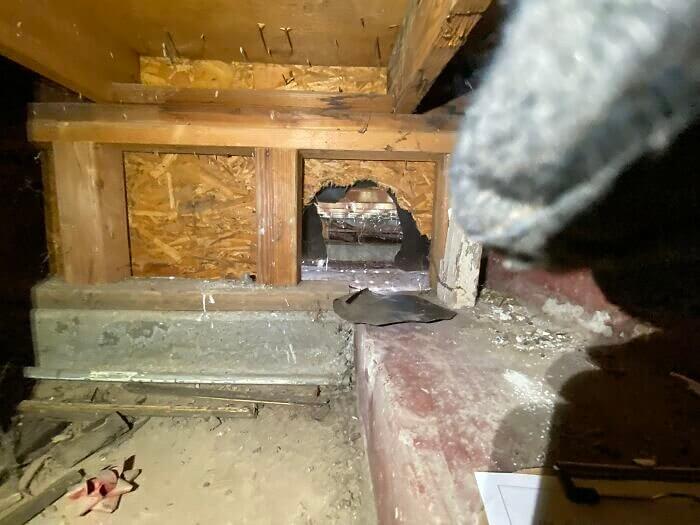
Even more outrageous about all this is that the homeowners had already been complaining about the rodent problem they had to face. Actually, we believe they found how they got in!
A DIY Bodge Job Gone Wrong
Here the fact that seeing faults in your home can be very annoying. Well yeah, that’s why we have small renovations, but big no one ever had fun with the big jobs – and it never comes cheap. And this one clearly wanted to skip the big check associated with getting their pier and beam house level, so they did it themselves. In order to accomplish this, they half-assed the nuts and bolts were coming up as jacks.
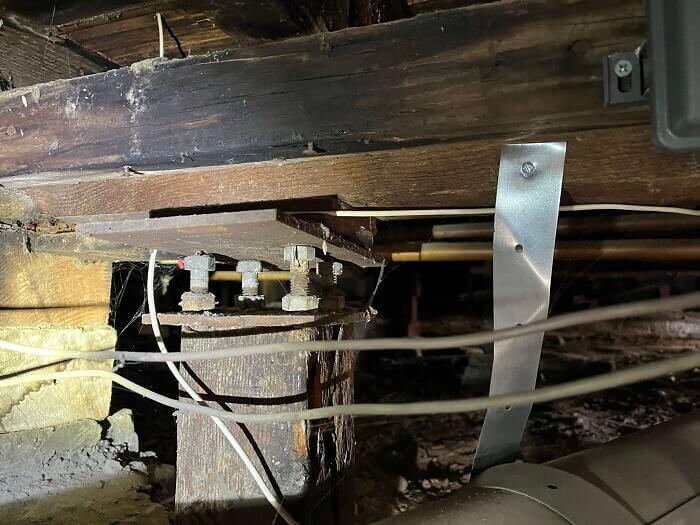
Advertisement – Continue Reading Below
Needless to say, the home inspection service that discovered this later was appalled to see that kind of work. That was not only dangerous but also a sloppy job!
A Bucket as a Pier? Just No
And what we’ve seen so far in pier and beam disasters should tell you just how integral the foundation is to a home. Without the proper support, one slip of a foots and your home comes crashing down! Which is why this guy who attended this structural inspection was shocked to see a bucket wedging up beams of someone’s house.
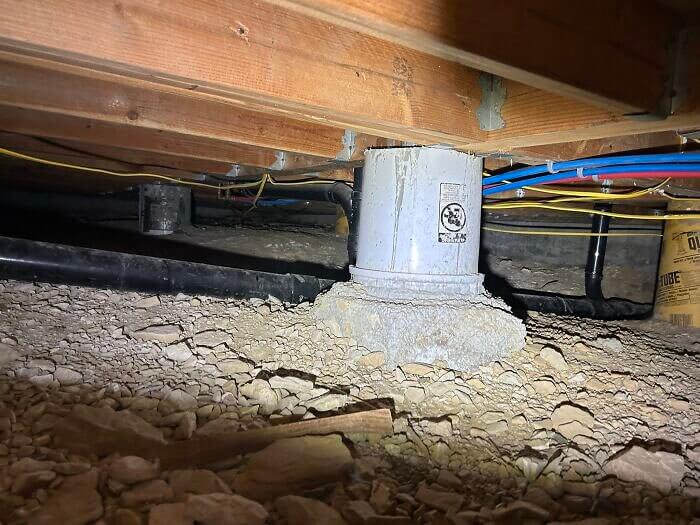
If this bucket was full of concrete, it’s still no substitute for a proper pier, and we’re scared to even think how much this house would have been suffering from this DIY blunder.
Oops, the Tree Hit the Roof
There are very few things that roofs of homes cannot withstand. They can slaughter the wind, they can slaughter wet conditions, and they even can slaughter dry and dry temperatures. A roof versus a massive tree is not a contest. Now, a lot of structural inspections would inform home owners that these trees that are potentially hazardous and close to their property need to be dealt with, but some folks just do not listen.
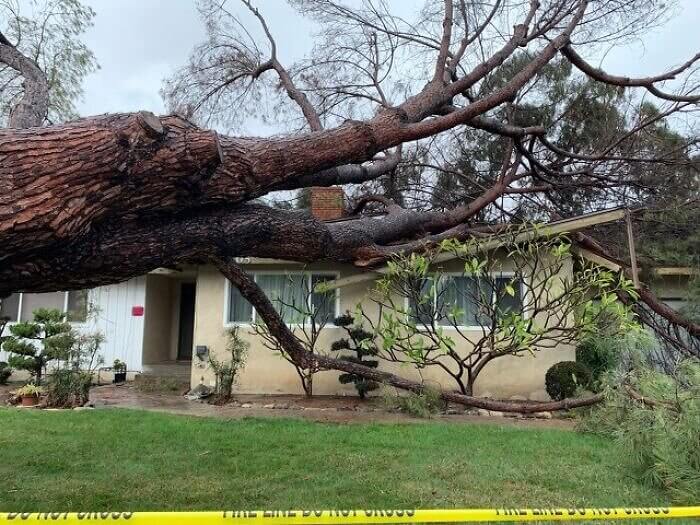
Advertisement – Continue Reading Below
To make matters worse, there is quite a few years worth of evidence of this tree getting hacked and tidied over the years. Why not trim up the base of it too?
Daylight Should Not Be Visible in a Crawl Space
Anyone who has ever made the trek down into the crawl space of their very own home knows, this area is dark, dark dark. The whole point of it is keeping it away from mainstream and keeping it intact to protect the whole structure of your house. However when the home inspection service ventured into the bowels of this crawl space, they were rather puzzled when they saw that they didn’t have to have their torches on.
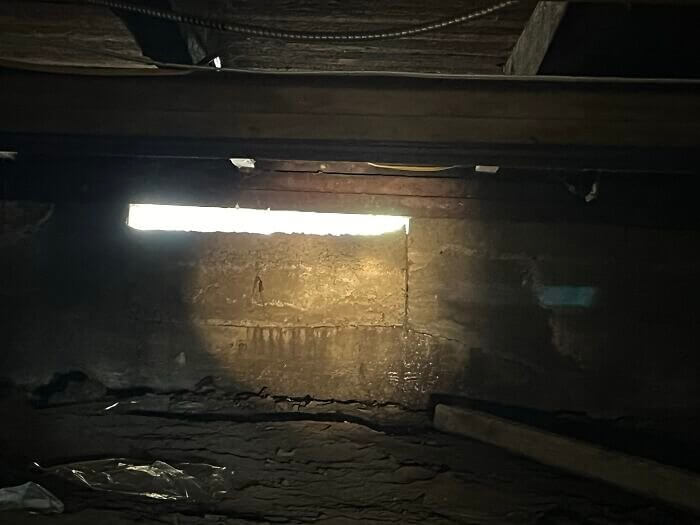
There was no did-Ohs instead, there was a hole in the wall! A breach in any of these areas is never a good thing as a crawl space will generally lead to mould, pests, moisture, and can even compromise the structure of your home.
That Crack Wasn’t on the Plans
A home inspection service does not only inspect your home from the inside but also provides exterior structural inspection services for your house. It was discovered when they were called out to this house which has a narrow footpath between it and the adjacent dwelling. However, when the water undermined this sidewalk, a crack occurred in the foundations, causing the water to flow down the hill eroding the neighbors backyard.

Advertisement – Continue Reading Below
That crack shouldn’t be there, as you probably guessed. And since this sidewalk was part of the homeowner’s property line, we’d guess that their neighbors were not having to pay for their lawncare costs.
How Many Pens Can You Fit in the Bricks?
While all these new fancy building materials are now used for all manner of modern renovations, bricks and mortar will always be in vogue. A brick wall can be immensely strong when built properly — but for it to be built correctly, the spaces between the bricks need to be filled with the mortar. Then again, you could have just shunted all this down! And any number one contractor will know you this, but this structural survey concluded that this wall was built by a cowboy builder.
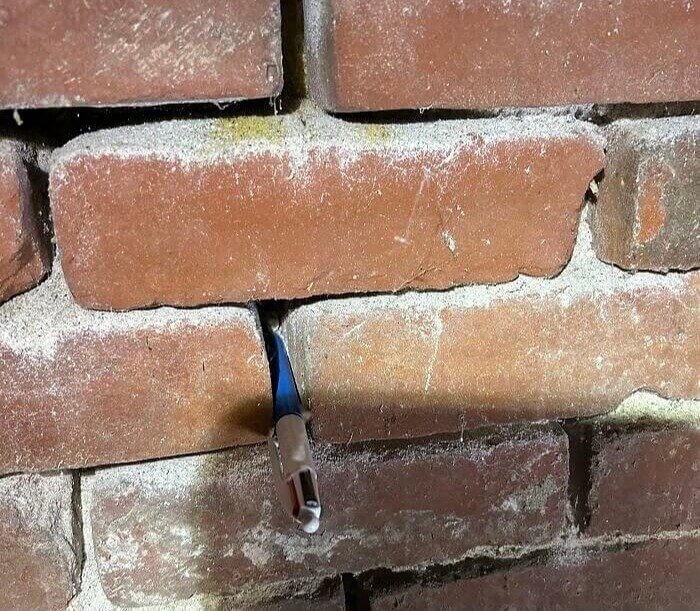
Ideally, you should not be able to fit a single pen into any of the gaps in the wall. But in this instance it appears you could fit an entire shop’s worth of pens into the gaps.
When the Stairs Come Away From the House
Since settlement in homes is common, home inspection services are accustomed to it. Minor settlement is usual in new constructions since they ‘settle’ on their brand-new foundations, yet settlement in older buildings is a cause for concern. Anything beneath ground level, locally called foundations of the building, cannot take the scale of that house if they are not strong or broken somehow, and parts of it can fall down. In this instance though, it was the staircase that was a vicim of this return to the roots technique.
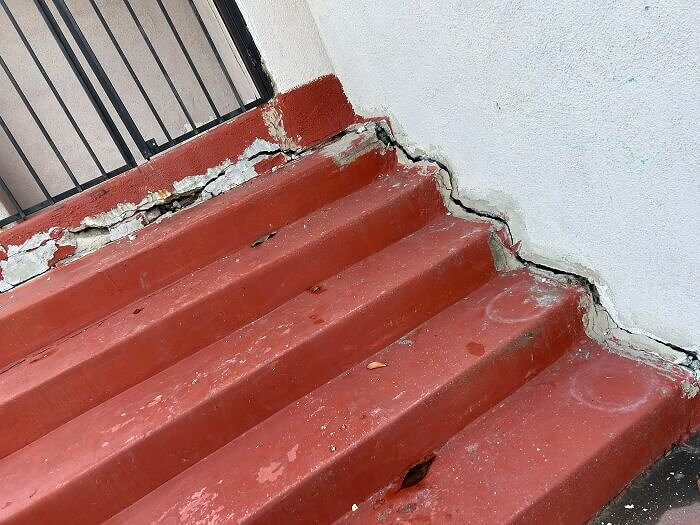
Advertisement – Continue Reading Below
Notice how the front of the house and the stairs are moving apart, completely disconnecting the stairs from the house. In a few more years they’ll be fallen apart.
The Retaining Wall Is Being Iced Out
Have you ever been in a group of friends and it seems like you are being pushed away? Well, that’s basically what’s going on here. This wall, once a great portion of this backyard, but obviously not the biggest thing in the world according to the tree that grew behind it. Its roots have spread so deep that their strength has begun working against the wall by moving it out of place. And as you can see, it looks like the whole wall is warped.

A home inspection service was summoned to check it out, and we can only assume they were not terribly impressed by the homeowner’s half-hearted effort to brace the wall with a couple of two-by-fours.
Those Support Beams Should Be Connected
Moving and erosion are two things that are common with hillside properties — as you have already seen up until this point. Because of this, they must be constructed on stable and solid supports, that should ensure that they are ever off the ground. And at first glance, it seems that this is house could really be propped up. I mean, just-underneath-the-house been-over-built-massive-maze-of-support-beams-and-they’re-all-crossing-each-other-for-more-support over the house.
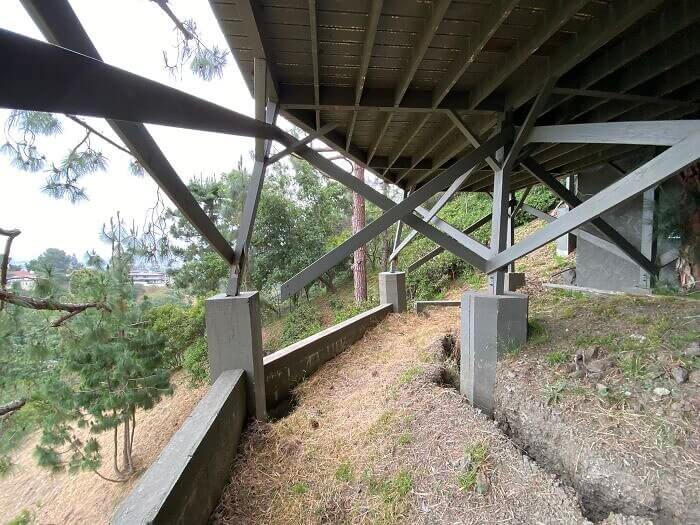
Advertisement – Continue Reading Below
But if we look closely we can see that some beams have nothing connected to them. In this scenario, they will provide not even a shred of scaffolding to hang onto.
No Parking, Please
When multiple structural inspections now underneath the net crawl space of a house, these crazy problems are unmasked. They have seen all these piers and beams that should never be used, they have seen mould and fungus, they have seen wiring that you can tell is unsafe, and piping that is concerning. Okay fine the rust on the steel beam under this house was a little worrisome but there’s no denying this sign put a bit of a smirk on their face.
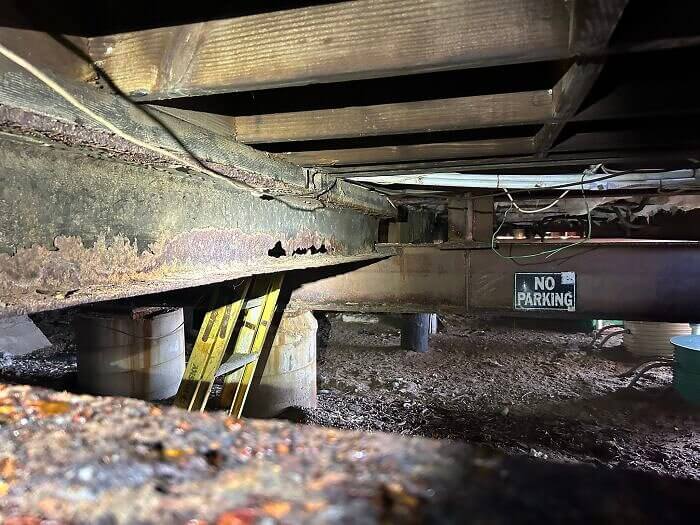
Now a ‘No Parking’ sign doesn’t need to go under this home, of course, but we found it pretty hilarious that it is there. Or maybe house for ants?
Thank Goodness the Trees Caught This Wall
This is even more critical for retaining walls that are placed on the property grounds for hillside properties. However, home inspection services are regularly getting out to homes just like this one, that erosion has had its way, and the walls have completely given way. This typically occurs when the retaining wall is substandard and unable to hold up to the constant changes of the hillside environments. And that is what happened here.
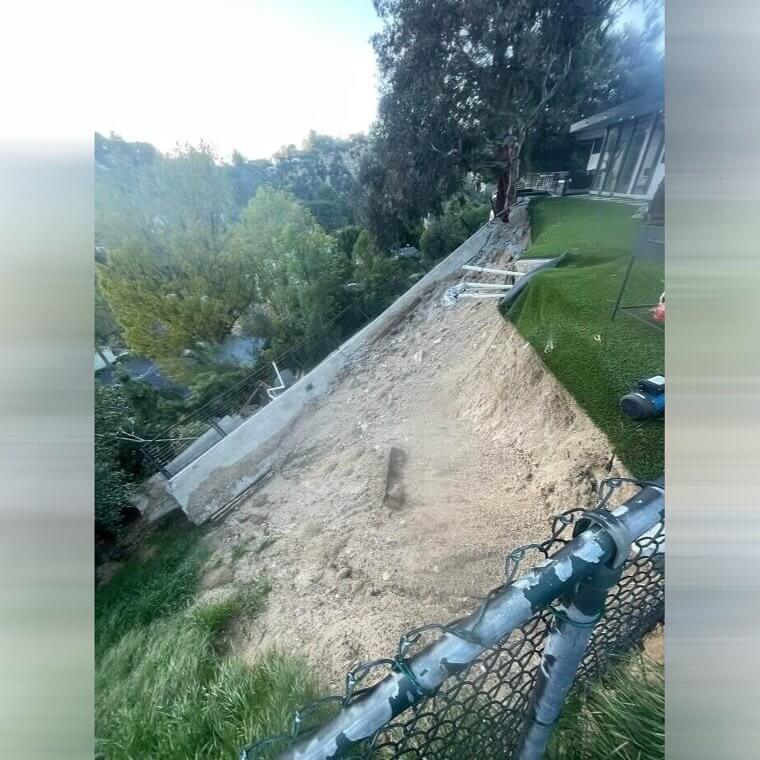
Advertisement – Continue Reading Below
This time, the homeowners got a little lucky. Otherwise, the retaining wall would’ve just gone right over their neighbors’ roof—and that would’ve cost a fortune.’
That Much Fungus Is Not a Good Sign
See, when you hear fungus, you probably imagine grotesque mold or appendages resembling mushrooms sprouting off a structure. But have you ever seen fungus like this? The home inspection service gasped audibly when they crawled beneath the house and saw this with their own eyes. And we don’t blame them. You don’t see fungus leaking through the ceiling every day.
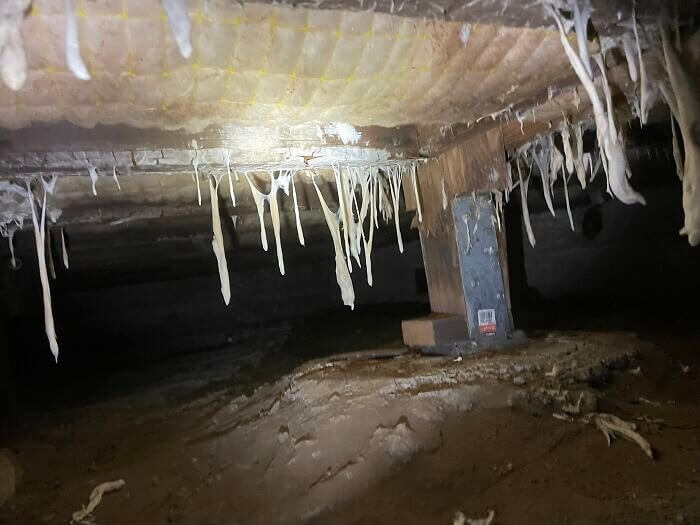
Another thing that you can clearly get visualize is it can be clearly seen that the wood seems to be wet and decayed and also the wood seems to made from some material which appears to be bent and shape. Hopefully this entire thing got erased.
It’s Time to Say Goodbye to This House
Beachfront homes also go for millions simply because everyone likes to live in stilt houses over the beach and over the water. That said, you’d best know what you’re getting yourself into if you purchase one of these homes, and it’d be wise to take a close look at the house before putting pen to paper. Because wood and saltwater aren’t a great match, everyone in their right minds wouldn’t splurge on an oceanfront wood hands-down, right?
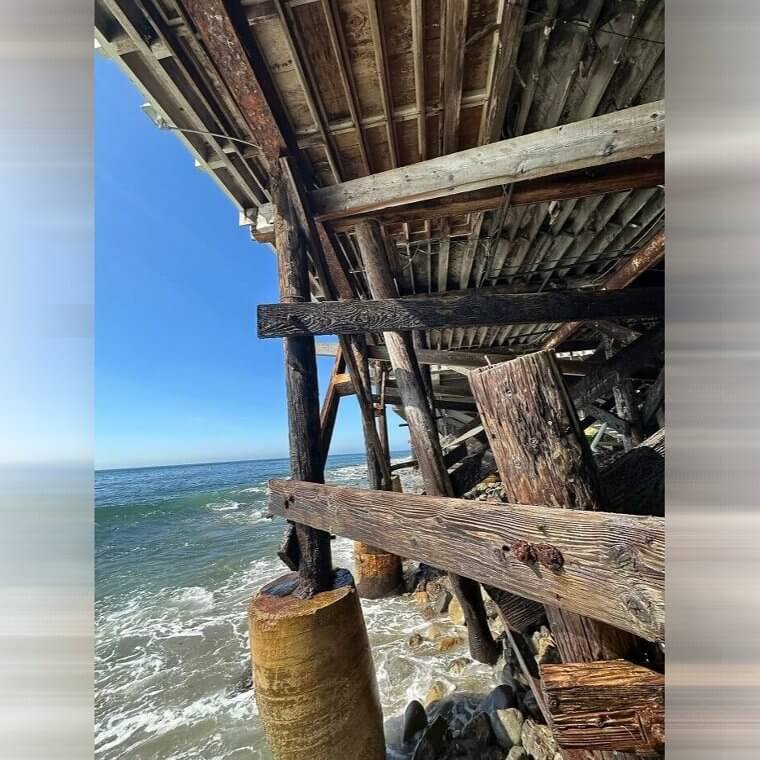
Advertisement – Continue Reading Below
Our home inspection service uncovered this home that had all of the beams bowed, some completely decayed and looking like the whole shebang was one dépanneur too many from collapse.
When a Bad Leak Goes Awry
But the fact is a lot of houses around the world do have leaking problems too. Your bath could be running with the tap left on, you could have leaky pipes, or you could experience inclement weather. However, something you should realize is a great deal of water may change the structural integrity of your house. After all, this family surely had no need for a structural inspection to tell them that the supporting structure under the deck was deterred by the leak.

When the deck collapsed, leaving a big crack through the middle, they knew something was wrong. But hey, at least there is a cone out saying you should probably not walk in there?
If a House Moves, so Does the Sidewalk
At this point, you should be aware of the fact that home inspection solutions find settlement issues rather frequently, making this more usual than you may believe. However, they’d never seen a house shift so much that its movement had actually displaced the public sidewalk in front of it. That is what happened here, and you can see how far this sidewalk has moved and how bad it has become.

Advertisement – Continue Reading Below
Structural inspections, in this case of a home in Mississauga, were straightforward in diagnosing the issues — but engineers weren’t solely concerned with this one home. We made them think that the integrity of the entire street was in question because of the whole mess.
Seeing Settlement From Down Below
Literally the majority of people do not want to crawl underneath their house, since that area is undefined, dark and very unusual. However, there are times, and when you have flooring problems or cracks in the walls, looking at home from below is a great way to find out what’s really going on, So when the home inspection service got called to this property, they went straight underground and were quick to spot the trouble. This is what settlement looks like from the bottom up.
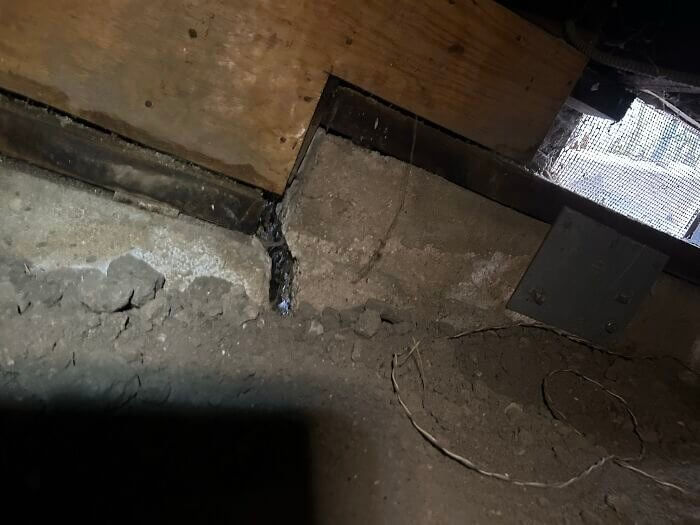
There is a large seam and fissure between the wood, and the cement that represents an enormous gap not meant to be there, as you can see in the image above. Instead, this is all meant to be flush.
Your Home’s Worst Enemy: Efflorescence
And when anyone uses the word effervescent to describe you, we say take that as a compliment and high-five yourself. But when a home inspection service informs you that you have efflorescence, then you better look up the balance in your bank account, because you’re going pal to have to pay out a large sum of money to cure that one. Efflorescence derives from dissolved minerals moving through a solid and staining it in the process, and this almost always portends a big (and budget-draining) water leak.
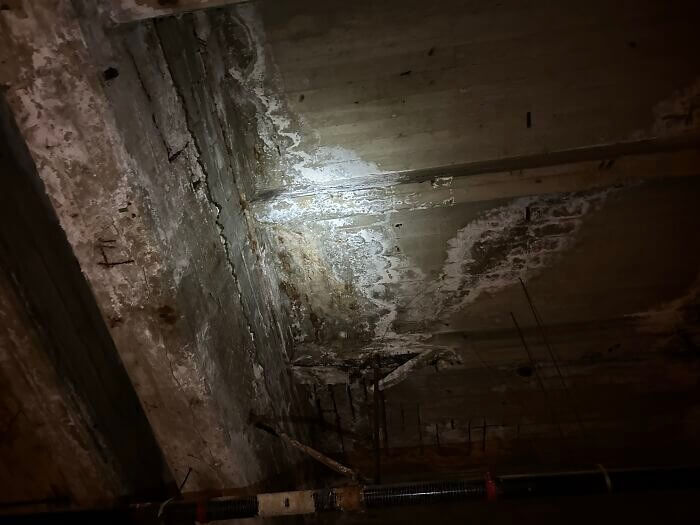
Advertisement – Continue Reading Below
Not-so-good-news for the homeowners that the structural inspector caught this, but great news for the home. This allowed them to concentrate on addressing the concern and, thus, resolving the issue.
This River Rock Won’t End Well
There are a plethora of construction materials available, and builders use diverse materials to make foundations. However, no good builder will ever use river rock for this, because it’s outrageously unstable and needs all kinds of other reinforcement and engineering in order to be safe and secure for a home. Which didn’t stop the builder of this house from using it – and in a quake zone at that!
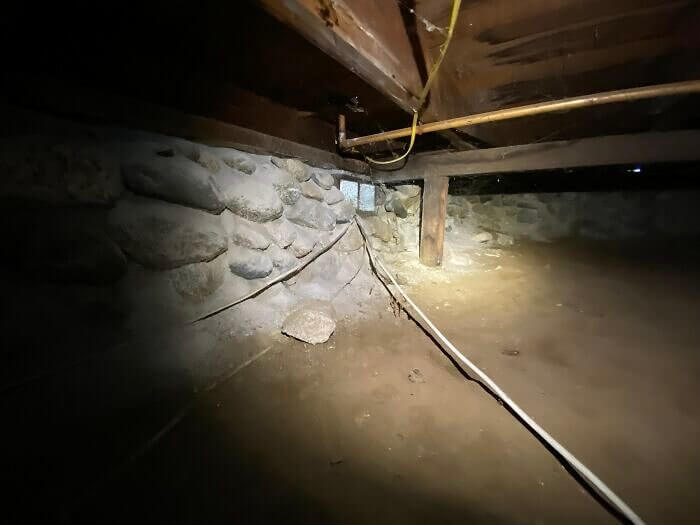
As the home inspection service managed to look at the underside of this house, they weren’t impressed. These are made with river rock and there is almost nothing else holding this structure together.







